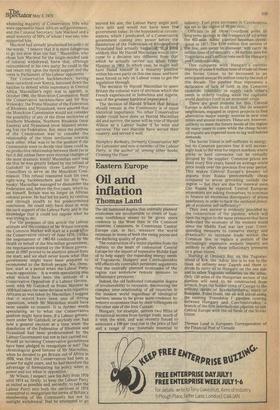Eastern Europe
Oil and inflation
Thomas Land
The old fashioned dogma that centrally planned economies are invulnerable to crises of business confidence seems to be given more credence in the West than in the Comecon countries. Consumers, in Communist Central Europe can, in fact, measure the world recession in terms of both the rising prices and the declining quality of goods.
The construction of a major pipeline from the Adriatic to the heart of communist Central Europe for the import of expensive Middle East oil to help supply the expanding energy needs of Yugoslavia, Hungary and Czechoslovakia will effectively contradict persistent arguments that the centrally planned economies of the region can somehow remain immune toinflationary pressures.
Indeed, the old fashioned communist dogma of invulnerability to recession, discounting the complex inter-relationship of all countries in the modern world regardless of ideological barriers, seems to be given more credence by western economists than by their colleagues on the other side of the Iron Curtain.
Hungary, for example, derives two fifths of its national income from foreign trade, much of it with the west, and was recently forced to announce a 100 per cent rise in the price of fuel and a range of raw materials essential to industry. Fuel price increases in Czechoslovakia are in the region of 90 per cent.
Officials in all three countries point to long-term savings in the transport of oil when the 457-mile 'Adria' pipeline becomes operational in 1977. The $350 million first section of the line, one meter in diameter, will carry 34 million tons of oil annually — 24 million tons for Yugoslavia and 5 million tons each for Hungary and Czechoslovakia.
This compares with Hungary's current imports of some 6 million tons of crude oil from the Soviet Union, to be increased to an anticipated annual 81/2 million tons by the end of this decade. The pipeline thus represents a declaration of lack of faith in the Comecon countries' reliability to supply each other's needs in orderly trading while the capitalist world destroys itself in an economic crisis.
There are good reasons for this. Central Europe is deficient in oil and, like its western neighbours, engaged in urgent projects to find alternative major energy sources in new coal mines and atomic reactors. These are, however, unlikely to meet the future needs of the region for many years to come while the cheap Soviet oil exports are expected soon to lag well behind demands.
The Soviet Union is self-sufficent in energy, but its Comecon partners fear it will increasingly look to the west for export markets where prices in hard currencies can be virtually dictated by the supplier. Comecon prices are fixed every five years, based on average world price levels over the previous five-year period. This makes Central Europe's present oil imports from Russia phenomenally cheap compared to prices prevailing outside the region — but they are due for renewal soon. Can Russia be expected, Central European economists are asking themselves, to continue to finance an enormous discrepancy of prices indefinitely in order to back the outdated principle of economic self-sufficiency? Their own answer is evidently provided by the construction of the pipeline, which will open the region to the same pressures that have bedevilled the economy of the western world since the Middle East war last year. Corresponding measures to conserve energy and drastically to increase trade within the Comecon bloc to replace a portion of the increasingly expensive wes,tern imports are unlikely to offset these inflationary pressures to a great extent.
Starting at Omisalji Bay on the Yugoslav island of Krk, the 'Adria' line is to run to the Sisak oil refinery near Zagreb and there to divide to carry oil to Hungary on the one side and to other Yugoslav refineries on the other. Only 130 miles of the Hungarian section of the pipeline will need to be constructed from scratch, from the border town of Csurgo to the refinery centre of Szazhalombatta, south of Budapest. From there, the oil will travel along the existing 'Friendship I' pipeline running between Hungary and Czechoslovakia, abranch of the first international pipeline to link Central Europe with the oil fields of the Soviet Union.
Thomas Land is European Correspondent of the Financial Post of Canada


































 Previous page
Previous page